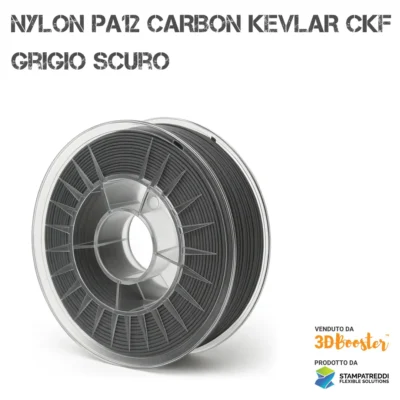The 3D printing industry is in constant evolution, and today more than ever the choice of materials is crucial to achieving professional, durable and lightweight results. In particular, the combination of nylon PA12 with aramid fibre (Kevlar) and carbon fillers – known as PA12 Carbon Kevlar – is gaining widespread acclaim among those seeking superior performance in sectors such as automotive, marine and mechanical applications involving contact.
In this article, we will delve into the distinctive features of this filament and explain why it proves so effective, highlighting the specific advantages offered by the aramid fiber and carbon fiber fillers used in combination.
1. Composition and main advantages
The filament made from the nylon PA12 engineering polymer loaded with aramid and carbon fiber, also known as carbon-kevlar loaded filament or carbon and aramid fiber loaded filament, delivers a unique balance of strength, light weight, and ease of printing. Here are its key strengths:
- High chemical inertia: thanks to the kevlar loading, the material withstands attack from many chemical agents. This characteristic translates into greater durability of the printed part, even in hostile environments or under extreme conditions.
- Improved inter-layer adhesion: the presence of aramid fiber promotes a more uniform fusion between layers, reducing the risk of delamination and increasing the final strength of the part.
- Self-lubricating: both the aramid reinforcement and the PA12 nylon matrix give the filament self-lubricating properties, making it ideal for components subjected to frequent motion or friction (gears, joints, bushings, etc.).
- Eye-catching aesthetics: the dark tint provided by the carbon and the slightly matte appearance of the Kevlar give printed parts a professional, modern look that is equally suited to prototypes and design pieces.
- Excellent mechanical properties: the combination with carbon fiber (which, together with Kevlar, reaches a total content of 15%) provides stiffness and strength while keeping the density of the printed part low. In other words, you obtain a component that is lightweight yet extremely robust.
2. Main applications
Thanks to its versatility, aramid filament combined with carbon is used in a wide range of industries:
- Automotive: body panels, brackets, and components exposed to mechanical stress or high temperatures.
- Naval: components requiring resistance to water and marine chemical agents.
- Contact mechanics: gears, bushings and bearings, where the self-lubricating property proves extremely advantageous.
- Model aircraft and drones: lightweight design is essential to enhance flight performance.
Thanks to its strength and lightness, this filament is increasingly valued for functional prototypes, short production runs, and end-use parts.
3. Printing tips
To get the most out of 3D-printed Kevlar (or 3D-printed aramid) features, keep the following tips in mind:
- Extrusion temperature: nylon PA12 generally requires higher temperatures than other filaments. Always check the manufacturer’s recommendations.
- Heated build plate: to prevent warping, it is advisable to use a heated bed and ensure optimal initial adhesion, possibly by applying dedicated adhesives.
- Pre-drying: nylon tends to absorb moisture, so store the filament in a dry environment and, if necessary, perform a pre-drying treatment before printing.
- Reinforced nozzle: abrasive fibres (such as carbon or aramid) can quickly wear out brass nozzles. A hardened steel or ruby nozzle is recommended to extend service life.
4. Why choose PA12 carbon kevlar
The combination of carbon- and Kevlar-reinforced filament in a PA12 nylon matrix yields a premium-grade material. High chemical inertia, self-lubrication, superior inter-layer adhesion, and remarkable lightness converge with outstanding mechanical properties. In short, this filament delivers a competitive edge to anyone who needs functional prototypes or low-volume production parts designed to withstand high loads without increasing overall component weight.
If you operate in the automotive or marine sectors, or simply need to produce exceptionally strong components, choosing an aramid-filled filament combined with carbon can make all the difference.
5. Learn more
If you would like more information on the features and applications of PA12 Carbon Kevlar, visit our dedicated page right away, which delves into every aspect of this extraordinary material. You will also find useful tips on print settings and guidelines to achieve professional results from the very start.
With kevlar reinforcement and a carbon loading of 15% by weight, the pa12 carbon kevlar filament stands out as a premium choice for those seeking parts that withstand mechanical stress, remain chemically inert, and stay lightweight. Thanks to its versatility, enduring high temperatures and demanding operating conditions becomes easier, without sacrificing a refined, modern appearance.
In conclusion, the ease of printing (with the necessary precautions) and the broad range of applications position 3D-printed Kevlar as one of the most high-performing materials on the market. Get ready to create innovative, functional, and long-lasting projects by leveraging a filament with extraordinary properties like PA12 Carbon Kevlar.
Visit our PA12 Carbon Kevlar page and discover all the details about the 3D printing filament reinforced with aramid and carbon fiber.
NYLON PA12 CARBON KEVLAR CKF GRIGIO SCURO
scopri il filamento NYLON PA12 CF fibra di carbonio (CF) Nero da 800g, un tecnopolimero per stampa 3d dalle caratteristiche uniche.
Resistenza alla temperatura, Resistenza meccanica, facile da stampare, elevatissima adesione tra i layer, finitura estetica di pregio.
Indicato per applicazioni professionali e industriali.
made with ♥ in Italy, Europe
